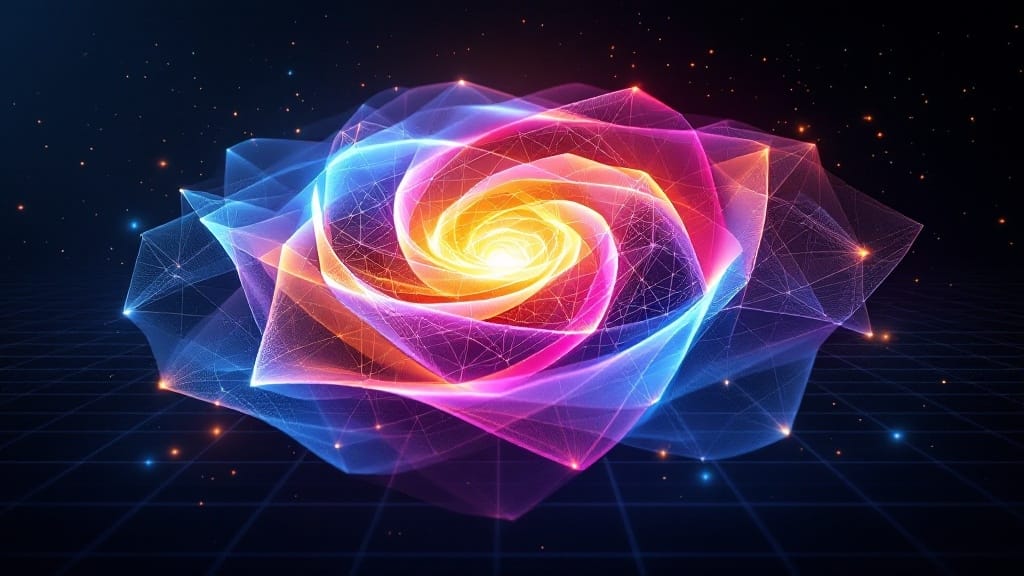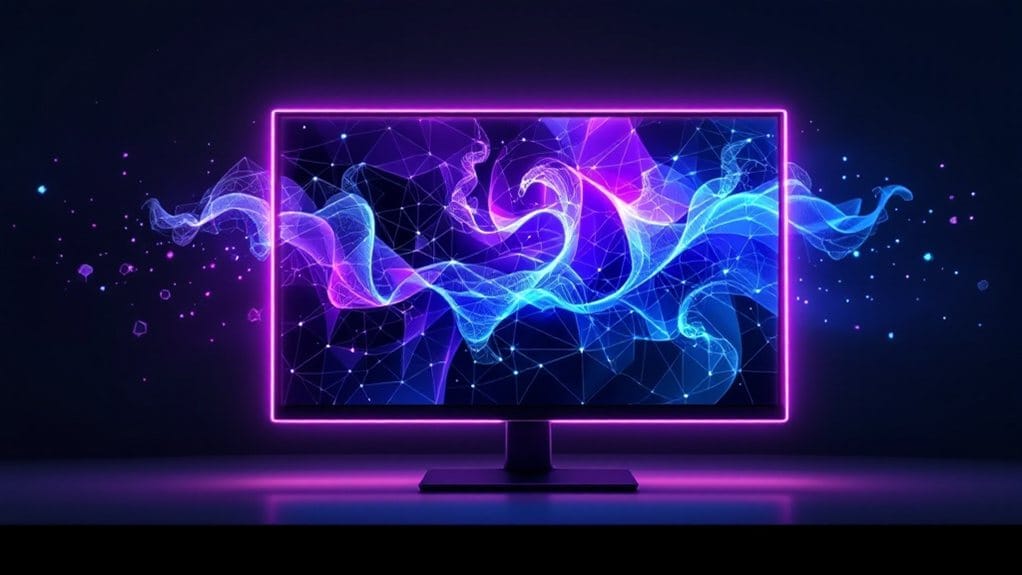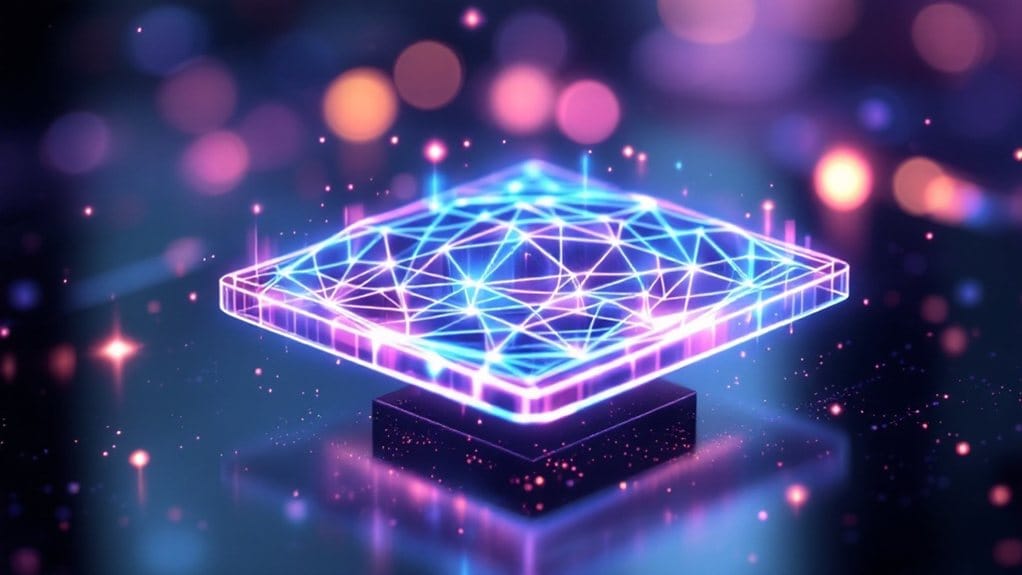Generative art NFTs combine algorithmic art creation with blockchain-based ownership verification, allowing artists to program unique digital artworks through code. These pieces are created using specialized programming languages and smart contracts that automate the minting process while guaranteeing authenticity. The technology enables artists to produce distinctive collections where each piece maintains individual characteristics while contributing to a larger artistic vision. Understanding the technical foundations of generative art NFTs reveals their transformative impact on digital creativity and ownership.

As digital art continues to evolve alongside blockchain technology, generative art NFTs have emerged as a groundbreaking fusion of algorithmic creativity and digital ownership. These unique digital artworks are created through sophisticated algorithms and programming languages like Processing, p5.js, and Python, allowing artists to establish predefined parameters that generate distinct pieces automatically. This creative approach first gained prominence in the 1950s with pioneering artists exploring computer-generated art. The resulting works represent a symbiotic relationship between human creativity and computational processes, where artists focus on creative coding rather than traditional manual techniques.
The technical foundation of generative art NFTs relies on smart contracts deployed on blockchain networks, which automate the minting process and guarantee each piece’s authenticity and provenance. These artworks can incorporate diverse elements, from abstract patterns and fractals to realistic paintings, often featuring interactive components that respond to user input or external data sources. The blockchain’s immutable nature solves the longstanding challenge of digital art replication by introducing verifiable scarcity and ownership records. Popular platforms like Art Blocks offer curated spaces for artists to showcase their algorithmic creations. Similar to traditional NFT trading cards, artists can use digital design tools to create the initial artwork before implementing generative elements.
Smart contracts and blockchain technology revolutionize digital art by ensuring authenticity and enabling unique, interactive generative artworks with verifiable ownership.
The market for generative art NFTs has experienced significant growth, driven by collectors’ interest in acquiring unique pieces that exist within larger, cohesive collections. Artists, typically well-versed in both programming and artistic principles, can now create expansive series of works where each piece maintains individual distinctiveness while contributing to a broader artistic vision. The ability to generate numerous variations from a single set of rules has opened new creative possibilities and revenue streams for digital artists.
The technological infrastructure supporting generative art NFTs enables complex features such as evolution over time, integration with machine learning algorithms, and real-time data incorporation. These capabilities extend beyond traditional static artwork, creating dynamic pieces that can change and respond to diverse inputs while maintaining their core artistic integrity.
Through blockchain technology, artists can now receive direct compensation for their digital works, while collectors benefit from transparent ownership records and the ability to trade their pieces in a decentralized marketplace.
FAQs
Can I Create Generative Art NFTS Without Coding Experience?
Creating generative art NFTs without coding experience is entirely feasible through no-code platforms.
Modern NFT art generators offer intuitive interfaces, pre-built templates, and layering systems that handle the technical complexities. Users can utilize AI tools like DALL-E or drag-and-drop features to generate unique combinations of traits, while platforms automatically manage blockchain integration, smart contracts, and metadata generation for seamless NFT creation.
What Blockchain Platforms Are Best for Minting Generative Art NFTS?
Three major blockchain platforms stand out for minting generative art NFTs, each with distinct advantages.
Ethereum remains the market leader with established platforms like Art Blocks and proven success with projects like Autoglyphs.
Tezos offers cost-efficient minting through fxhash, making it ideal for artists seeking lower transaction fees.
Solana provides high-speed transactions and accessibility, though its generative art ecosystem is less developed than its competitors.
How Do I Protect My Generative Art NFT From Unauthorized Copying?
To protect generative art NFTs from unauthorized copying, creators should implement a multi-layered approach: register copyrights formally with relevant authorities, embed unique digital watermarks within the artwork, and utilize blockchain monitoring tools to track potential infringement.
Furthermore, creators should employ smart contracts with clear ownership terms, maintain thorough documentation of the creation process, and regularly issue DMCA takedown notices when unauthorized copies are found.
What Tools Do Professional Generative Artists Use to Create NFTS?
Professional generative artists primarily utilize advanced coding frameworks like Processing and p5.js for algorithmic creation, while incorporating specialized tools such as CryptoArt.AI and NightCafe for AI-driven elements.
For 3D components, Blender serves as a versatile platform, while smart contract development relies on Solidity.
Technical artists often combine these with custom Python scripts and traditional design software like Adobe Creative Suite for post-processing refinements.
Are Generative Art NFTS More Valuable Than Traditional Digital Art NFTS?
The value comparison between generative and traditional digital art NFTs remains highly subjective and market-dependent.
While generative art NFTs often command higher prices due to their algorithmic complexity and technical innovation, traditional digital art NFTs can achieve similar valuations based on artistic merit and creator reputation.
Market data shows both categories experiencing comparable price volatility, with individual pieces from either type potentially reaching multi-million dollar valuations.









